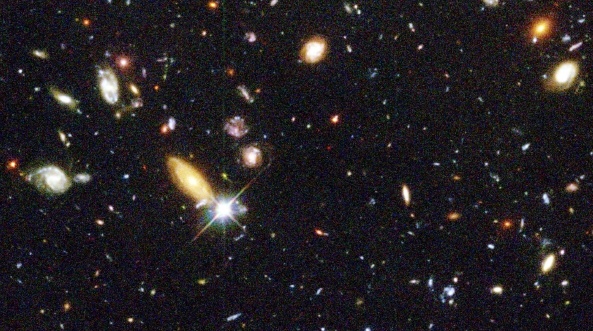The Northwestern University Astronomy Web Lab Series
Adapted for use at Western Kentucky University
Determining the Extragalactic Distance Scale
One of the fundamental quests in astronomy today is the determination
of the distance scale in the universe. When you look at the sky at
night, how can you translate what you see into a three-dimensional
picture? Are brighter objects brighter because they are closer, or
because they are intrinsically brighter? Are bigger objects bigger
because they are closer, or because they are intrinsically bigger?
These and other questions have been pushed to the forefront of
astronomy as ever improving technology enables us to see objects
billions of light years away. How big is the universe? How old is
it? How is matter distributed within it? Why is the universe the way
it is? How did it come to be that way? The branch of astronomy which
investigates the large-scale structure of the universe, and how that
structure came to be, is called cosmology.
A number of techniques are required to map the three-dimensional
universe. In this lab you will focus on a particular technique that
is useful for measuring distances to neighboring galaxies, and the
nearest galaxy clusters. You will use actual Hubble Space Telescope
(HST) images to find the distance to a galaxy named M100, by looking
for a variety of variable stars known as Cepheid variables.
(The determination of the extragalactic distance scale was one of the
Key Projects for the Hubble Space
Telescope). You will then use your newly-determined M100 distance to
estimate the age of the universe!

Above: A portion of the Hubble Deep Field (HDF). In
December 1995, 10 days of HST observing time were devoted to long
exposures, through filters of different colors, of a tiny patch of
"blank sky." The long exposures enable us to see very faint, faraway
objects. Single-color exposures were combined to produce this
multicolor image. The region is filled with galaxies of diverse
morphologies and colors! Some of the faintest objects in the HDF are
so distant, the light we now see from them was emitted over 10 billion
years ago, when our universe was still young! To turn this
two-dimensional image into a three-dimensional map, one needs to know
the distance to each object in the image. Distances are also needed
to determine the physical diameters and intrinsic luminosities of each
galaxy. The field shown is approximately 40 by 70 arcseconds of sky.
(For comparison, the diameter of the full moon is about 1800
arcseconds.) More images and information on the Hubble Deep Field may
be found in the public Web
pages of the Space Telescope and Science Institute (STScI). Image
credit: Robert Williams and the Hubble Deep Field Team (STScI) and
NASA.
Table of Contents
Before You Begin
Measuring Cosmic Distances
Cepheids in M100
The Distance to M100
The Age of the Universe
A note on scientific error
Epilogue
Tutorial pages:
The lab sheet
References and Bibliography
Credits
Northwestern University version: 7 October 1998
Diane Dutkevitch (dutkevitch@nwu.edu)
Go to the Northwestern labs
Download versions are available for installation on local Web servers.
Local version last updated:
Yourname (name@address)
Local changes to the Northwestern version

